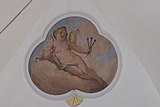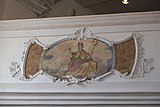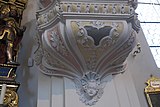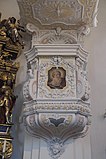St. Valentin (Unterföhring)
The Roman Catholic parish church of St. Valentin in Unterföhring , a municipality in the Munich district in the north of the Bavarian capital, was built on the foundation walls of a previous Romanesque building at the beginning of the 18th century at the transition from Baroque to Rococo . The church is consecrated to Saint Valentine of Raetia , one of the first bishops of Passau .
history
Remains of the foundations of the first church building from the Romanesque period were discovered during the thorough restoration in 1973. In the years 1650 to 1660, after the Thirty Years War , a major renovation must have taken place. In 1712 a new tower was erected, and in 1716 the Freising Prince-Bishop Johann Franz Eckher von Kapfing and Liechteneck commissioned the building of the new nave. In 1716/17 the old nave was demolished, in April 1717 the bishop laid the foundation stone and in 1718 he was able to consecrate the new church. The master builder was the master mason, Dominik Glasl , who worked in Freising . In 1745/46 the vestibule was added.
architecture
Exterior construction
The exterior is structured by large, rectangular glare fields. The tower rises on the south-west corner of the nave , on whose four square basement floors the octagonal bell-shaped storey covered with a shingled onion dome is built.
inner space
The church is a simple hall building . The nave extends over four yokes , the western end forms a double empore . The choir and nave are covered by barrel vaults with deep stitch caps. The walls are structured by rectangular pillars, which are decorated with capitals and richly profiled beams . The slightly retracted choir, to which a round arched choir arch leads, is semi-circular.
Piece
The stucco in the style of the Wessobrunn school was created by Thomas Glasl , the son of Dominik Glasl, Mathias Bader and Johann Rieder. The pulpit and the oratory parapet in the choir, on which the coat of arms of Prince-Bishop Johann Franz Eckher von Kapfing, who commissioned the church, is attached, are particularly richly decorated .
Frescoes
The frescoes were executed in 1718 and bear the signature of Nikolaus Gottfried Stuber in the nave . Presumably all the frescoes in the church can be attributed to him. The middle choir fresco is dedicated to Maria Immaculata , the smaller medallions on the side show symbols of Mary (olive tree, rising sun, Noah's ark ). The nave fresco depicts Jesus with the cross, surrounded by angels and church fathers, including a female figure with the papal cross and the divine virtues as the personification of the church, and the poor souls in purgatory on the lower edge of the picture . On the medallions in the stitch caps that frame the main picture you can see angels with the tools of passion .
Gallery
On the lower gallery parapet, St. Valentine of Raetia with the Unterföhringen church in the background, St. Korbinian , who is venerated as the first bishop of Freising , and the finding of the cross by St. Helena , mother of the Emperor Constantine the Great , are depicted. On the parapet of the upper gallery, which was built in later, you can see St. Cecilia at the organ.
Furnishing
- In the high altar with six-column structure from 1741 the group of figures of a coronation of Mary from the previous church is integrated, which is dated around 1650/60. The figures on the side represent St. Nicholas with the three golden balls and St. Dionysius of Paris , who carries a book with his severed head lying on it. In the extract from the altar you can see John the Baptist with a cross staff and the Lamb of God between two angel figures, both of which represent the Archangel Michael , on the left with the sword of fire and on the right as the weigher of souls . The seated figure made of limewood of the patron saint of the church , Saint Valentine of Raetia, surrounded by angel sputtles, was added in 1932. He is considered the patron saint of epilepsy , which the little figure lying at his feet is supposed to refer to.
- The side altars date from around 1680. On the north altar there is a crescent moon Madonna between St. Augustine and St. Helena , in the excerpt a small crucifixion group . The figures on the south side altar represent St. Wolfgang in the middle and St. Leonhard and St. Sigismund on the sides , in the excerpt God the Father .
- The large choir arch crucifix , like the Scourge Christ under the gallery, is dated around 1720.
- The richly stuccoed pulpit was created around 1718. It is decorated with the evangelist symbols on the volutes , the figure of Salvator Mundi stands on the sound cover . The fresco on the pulpit represents the apostle Paul .
literature
- Georg Dehio: Handbook of the German art monuments. Bayern IV: Munich and Upper Bavaria . 2nd edition, Deutscher Kunstverlag, Munich 2002, ISBN 3-422-03010-7 , pp. 1208–1209.
- Fritz Lutz, Britta R. Schwahn: St. Valentin Unterföhring . (= Small Art Guide No. 1435), Verlag Schnell and Steiner, Munich and Zurich 1983.
- Georg Paula , Timm Weski: District of Munich (= Bavarian State Office for Monument Preservation [Hrsg.]: Monuments in Bavaria . Volume I.17 ). Karl M. Lipp Verlag, Munich 1997, ISBN 3-87490-576-4 , p. 316-318 .
Web links
Coordinates: 48 ° 11 ′ 33.3 " N , 11 ° 38 ′ 19" E



















